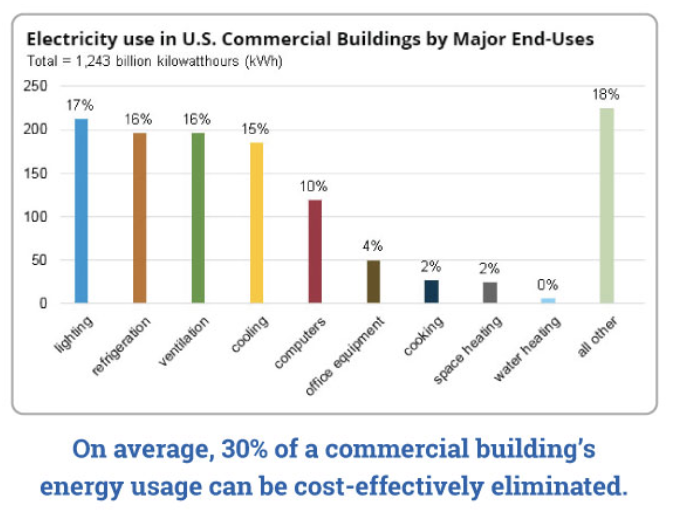A combination of increasing electricity prices, the need to stay competitive, and urgent environmental issues have companies across the U.S. reexamining their energy management practices. And for good reason. Nearly 82% of commercial buildings in the U.S. were built before 2000. As such they simply aren’t as energy efficient as they could be. On average, commercial buildings waste 30% of the energy they consume, and they consume 42% of the nation’s energy – more than any other sector.

The choices a company makes regarding energy consumption can profoundly impact its reputation and bottom line. In response, forward-thinking companies are taking a holistic, big-picture approach to energy management by investigating energy efficiency, generation, and sustainability opportunities at a company-wide scale.
This approach at first glance may seem to be the wrong one because managing energy can be particularly challenging for companies with multiple buildings or sites. Some buildings may be old, some new, some are large and complex, some are small and relatively easy to upgrade, some have on-site generation and others do not. So why would it be beneficial to look at solutions across an entire portfolio of buildings instead of the specific needs of individual buildings?
- More Likely to Secure Company Wide Buy In
When executives and stakeholders have clear information about energy inefficiencies within their portfolio of buildings and are offered solutions to track and improve performance, they are more likely to support and champion a company-wide energy management plan. Furthermore, a company may invest in energy management to further other high-level business goals and objectives. For example, a company may develop an energy management plan to align with other cost-cutting, operational, and environmental goals, such as:
• Reduce energy costs by X% over the next X years
• Increase renewable energy production by X%
• Reduce maintenance costs by X%
• Reduce downtime by X%
• Reduce greenhouse gas emissions by X% over the next X years
2. Ability to Benchmark and Compare Energy Usage for Every Building
Many companies across the U.S. lack a clear understanding of exactly how much energy they consume and waste – and the vast majority lack the systems needed for accessing energy data in real-time, and in a form that provides actionable information. Monitoring and analyzing energy use at different sites will reveal operating issues that affect costs, performance, and quality.

3. Unified Energy Management Efforts and Equipment Upgrades
A siloed approach toward energy management leads to no cohesive strategy for which energy conservation measures to pursue, how to measure results, and which vendors/equipment to select. Leaving these decisions to the individual building level results in a wide variety of projects and vendors with no clear way for the company to measure their overall effectiveness.
4. Reduced Cost and Time
Implementing energy management strategies for buildings separately from one another is a time-consuming process that frequently results in missed opportunities and unnecessary additional costs. For example, multi-building organizations can leverage the benefits of bulk purchasing to improve project performance and reduce implementation costs. The cost and time to evaluate projects can be reduced by identifying buildings with similar profiles and common denominators. Grouping buildings together that benefit from similar efficiency projects can shorten the timeline for implementation and increases the scale of energy savings. Additionally, grouping projects that require fewer upgrades and deliver immediate savings with more extensive projects that tend to have a longer ROI allows companies to achieve more, while still providing an overall favorable ROI for their energy management efforts.
5. Allows for a Pilot Project
At the individual building level, the idea of a pilot project does not really exist; it is either a project or not. However, at the multi-building level, a pilot project helps companies evaluate the results of proposed energy management projects on a manageable scale, thereby minimizing risk. Testing strategies on one building or site will allow the corporate team to examine the benefits and value of every recommended strategy and uncover any unexpected results or complications before it is rolled out to other buildings.
If your company is interested in taking control of its energy, SEMCO can help you develop an energy management plan that aligns energy goals with business objectives and facility-level operations to maximize results across your portfolio of buildings. Please contact us today to get started.

